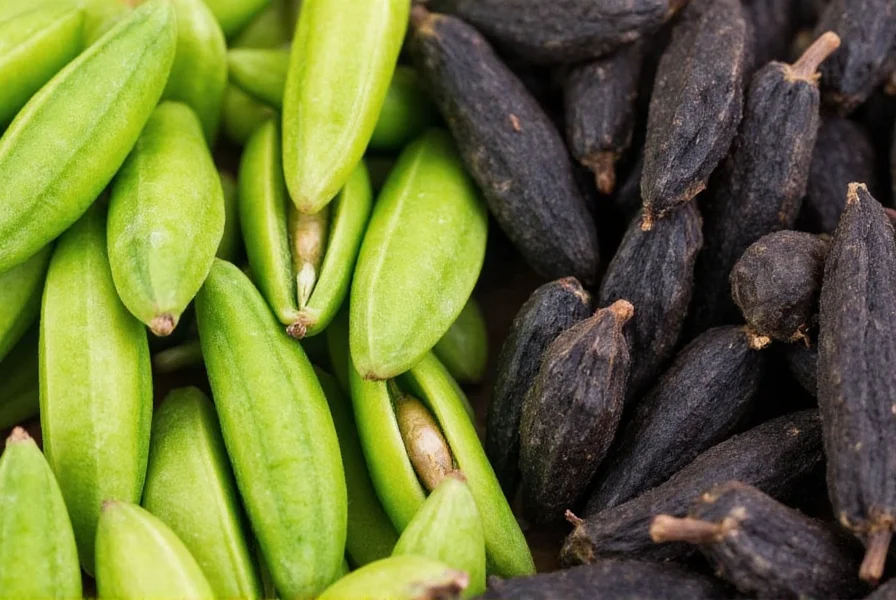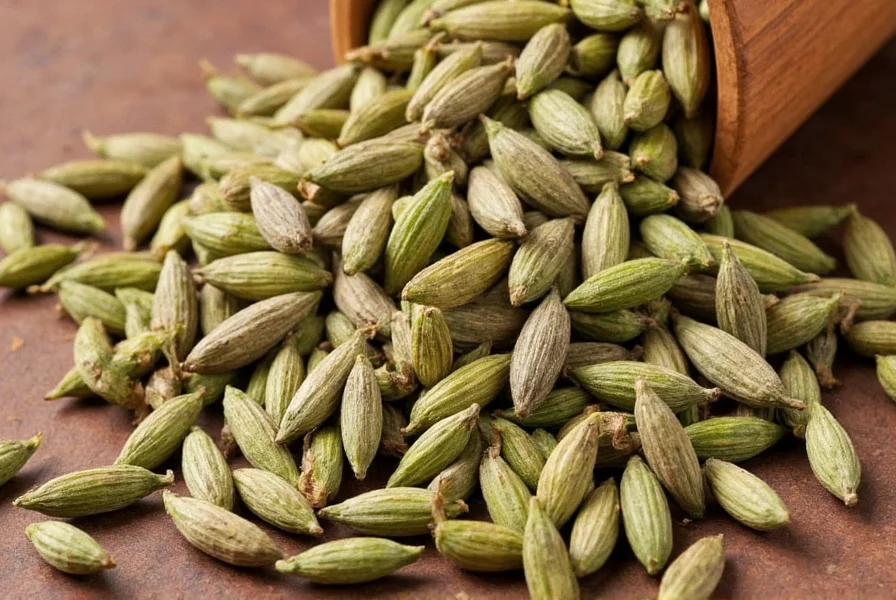Cardamom isn't just another spice sitting quietly in your pantry—it's one of the world's most valuable and ancient flavorings, second only to saffron in price among commonly used spices. Understanding what cardamom is and how to use it properly can transform your cooking and potentially offer health benefits that modern research continues to explore.
Types of Cardamom: Green vs. Black
When exploring what is cardamom, it's essential to understand there are two primary varieties that serve different culinary purposes:
| Characteristic | Green Cardamom | Black Cardamom |
|---|---|---|
| Botanical Name | Elettaria cardamomum | Amomum subulatum |
| Origin | South India | Himalayan region |
| Flavor Profile | Sweet, floral, citrusy, herbal | Smoky, camphorous, earthy |
| Common Uses | Baking, chai, rice dishes, desserts | Curries, stews, braises, savory dishes |
| Preparation | Seeds or whole pods | Whole pods only (remove before serving) |
Green cardamom, sometimes called true cardamom, features small, triangular green pods containing black seeds. It's the variety most commonly found in Western supermarkets and is essential in Scandinavian baking, Middle Eastern coffee, and Indian chai. Black cardamom, with its larger, dark brown to black pods, develops its distinctive smoky flavor through open-fire drying—a process that makes it unsuitable as a direct substitute for green cardamom in most recipes.

Historical Journey of Cardamom
The history of cardamom stretches back over 4,000 years, with references appearing in ancient Sumerian and Egyptian texts. Originally cultivated in the Western Ghats of southern India, cardamom became a prized commodity along the spice routes connecting Asia with the Middle East and Europe. Vikings are believed to have introduced cardamom to Scandinavia, where it remains a staple in baked goods like Finnish pulla and Swedish kardemummabullar.
Unlike many spices that lost popularity during certain historical periods, cardamom maintained its status as a luxury item across multiple civilizations. Ancient Greeks and Romans used it as a perfume and breath freshener, while Ayurvedic medicine incorporated it for digestive benefits thousands of years before modern science began investigating these properties.
Culinary Applications of Cardamom
Understanding what cardamom is means recognizing its versatility across global cuisines. The spice works exceptionally well in both sweet and savory applications, though the preparation method significantly impacts its flavor profile.
For optimal flavor when using whole cardamom pods in cooking, lightly crush them to release the seeds' aromatic oils. In baking, many chefs prefer grinding the seeds themselves rather than using pre-ground cardamom, which loses potency quickly. When substituting ground cardamom for whole pods, use approximately 1/8 teaspoon of ground spice for each pod.
Popular culinary uses include:
- Indian chai and masala chai blends
- Scandinavian sweet breads and pastries
- Middle Eastern coffee preparation (often combined with saffron)
- Rice dishes like biryani and pilaf
- Desserts including ice cream, custards, and fruit compotes
- Meat marinades, particularly for lamb and poultry
Nutritional Profile and Potential Health Benefits
Cardamom contains several beneficial compounds including terpenes, flavonoids, and essential oils that contribute to its potential health properties. One teaspoon (2 grams) of ground cardamom provides approximately:
- 13 calories
- 0.3g protein
- 0.2g fat
- 2.9g carbohydrates
- 1.2g dietary fiber
- Significant amounts of manganese, magnesium, and iron
Research suggests cardamom may offer several health benefits, though more human studies are needed to confirm many findings. Current evidence indicates potential benefits for:
- Digestive health: Traditional medicine systems have long used cardamom to alleviate digestive discomfort, and some modern studies support its potential to reduce nausea and improve digestion.
- Antioxidant properties: Cardamom contains compounds with antioxidant activity that may help combat oxidative stress.
- Blood pressure management: Preliminary research suggests cardamom supplementation might help lower blood pressure in people with hypertension.
- Breath freshening: The essential oils in cardamom have natural antibacterial properties that can help reduce oral bacteria.
When considering cardamom health benefits, it's important to note that most research uses concentrated extracts rather than culinary amounts. While adding cardamom to your diet is generally safe, don't expect dramatic health improvements from typical cooking quantities.
Selecting and Storing Cardamom
When shopping for what is cardamom in its various forms, quality makes a significant difference in flavor. For the best experience:
- Whole pods: Choose plump, green pods that feel heavy for their size and have a strong aroma when lightly crushed. Avoid brown or yellowing pods.
- Seeds: Look for dark black seeds inside the pods—pale seeds indicate older, less potent cardamom.
- Ground cardamom: Purchase in small quantities as it loses flavor rapidly. The best option is to grind your own from whole pods.
Proper storage extends cardamom's shelf life significantly. Keep whole pods in an airtight container away from light and heat, where they'll maintain quality for up to one year. Ground cardamom loses potency within 3-6 months. For long-term storage, keep cardamom in the freezer where it can retain flavor for up to two years.

Cardamom Substitutes and Alternatives
When you're wondering what is cardamom and need a replacement, several options exist depending on your recipe:
- Cinnamon and ginger combination: Mix equal parts cinnamon and ginger to approximate cardamom's warm, citrusy notes.
- Nutmeg and allspice: A blend of these spices can mimic some of cardamom's complexity in baked goods.
- Coriander and cumin: For savory dishes, this combination provides some similar earthy notes.
- Cardamom extract: When fresh cardamom isn't available, high-quality extracts can provide concentrated flavor.
Remember that no substitute perfectly replicates cardamom's unique flavor profile. When possible, seek out authentic cardamom for recipes where it's a featured ingredient, particularly in traditional dishes from cultures that have used it for centuries.
Cultural Significance Across Continents
Cardamom's journey through human history reveals its deep cultural integration. In India, it's considered auspicious and often included in wedding celebrations. Scandinavian countries consume more cardamom per capita than any other region, incorporating it into daily breads and pastries. Middle Eastern cultures traditionally serve cardamom-flavored coffee to guests as a sign of hospitality.
This global adoption demonstrates cardamom's remarkable versatility and enduring appeal. Unlike many spices that remain confined to their regions of origin, cardamom successfully integrated into diverse culinary traditions while maintaining its distinctive character.
Frequently Asked Questions
What is cardamom made from?
Cardamom comes from the seeds of plants in the ginger family (Zingiberaceae). The seeds develop inside small triangular pods on perennial plants that grow in tropical climates. Green cardamom (Elettaria cardamomum) produces light green pods, while black cardamom (Amomum subulatum) develops larger, dark brown to black pods. The seeds inside these pods contain the aromatic compounds that give cardamom its distinctive flavor and fragrance.
Is cardamom the same as cardamon?
Yes, cardamom and cardamon refer to the same spice. \"Cardamom\" is the more commonly accepted spelling in American English, while \"cardamon\" appears more frequently in British English. Both terms describe the aromatic spice derived from the seeds of plants in the ginger family. The spelling variation doesn't indicate any difference in the spice itself, its varieties, or its uses in cooking and traditional medicine.
Can I eat cardamom pods whole?
While cardamom pods are technically edible, they're quite fibrous and unpleasant to chew. Most culinary applications involve either removing the seeds from the pods or using whole pods for flavoring during cooking (then removing them before serving). In some traditional preparations like Indian chai, the pods are lightly crushed to release flavor but not consumed. The seeds contain the most concentrated flavor and are what most recipes intend when calling for \"cardamom\" without specification.
What does cardamom taste like?
Cardamom has a complex flavor profile that's difficult to describe with a single term. It combines citrusy notes (particularly lemon and orange), herbal qualities, subtle sweetness, and a distinctive eucalyptus-like aroma. Green cardamom tends to be more floral and delicate, while black cardamom offers a smokier, more robust flavor with camphor notes. When properly used, cardamom adds depth and complexity without overwhelming other ingredients, making it valuable in both sweet and savory applications.
Is cardamom good for digestion?
Traditional medicine systems including Ayurveda have used cardamom for digestive support for thousands of years. Modern research suggests cardamom may help reduce nausea, stimulate appetite, and ease digestive discomfort due to its essential oils and antioxidant compounds. Some studies indicate it might help reduce gas and bloating. While more research is needed to confirm specific mechanisms, many people find that consuming cardamom tea or chewing cardamom seeds after meals supports healthy digestion. As with any natural remedy, results can vary between individuals.











 浙公网安备
33010002000092号
浙公网安备
33010002000092号 浙B2-20120091-4
浙B2-20120091-4